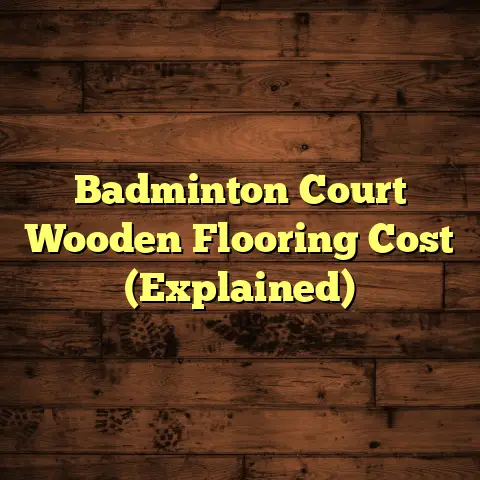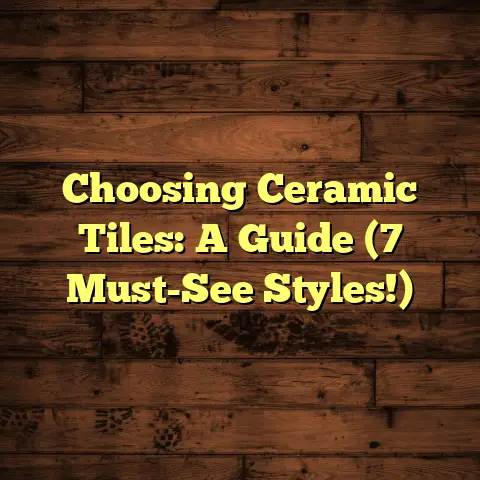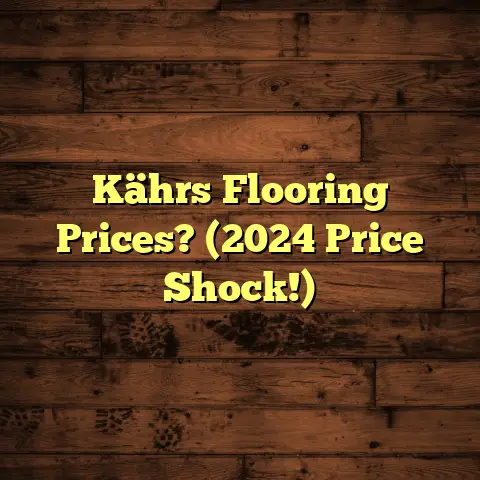Refinish Wood or Vinyl Plank? (2 Top Options!)
Flooring, it’s the unsung hero of any amazing space.
It’s not just something you walk on; it sets the entire vibe.
Think about it: Elegant, warm wood floors scream classic luxury.
Sleek, modern vinyl planks? They shout style and practicality.
Today, we’re diving into how to keep these beauties looking their best.
We’ll explore the magic of refinishing and restoring,
so you can keep your investment shining!
Section 1: Understanding Wood Flooring
The Allure of Wood Flooring
Let’s talk about hardwood. It’s timeless. It’s classic.
And frankly, it just feels luxurious underfoot.
I’ve walked into homes and instantly felt the warmth radiating
from a perfectly maintained oak floor.
It’s an instant mood booster!
We’re talking about options like:
-
Oak: The workhorse. Durable and readily available.
It’s what I often recommend for high-traffic areas. * Maple: Sleek, modern, and lighter in color.
It brings a sense of airiness to a room. * Cherry: Rich, warm, and adds a touch of sophistication.
Think cozy libraries and elegant dining rooms.
Each species brings something unique to the table,
contributing to a rich ambiance that’s hard to beat.
I remember one client who was torn between maple and cherry.
We ended up going with cherry in their living room.
The transformation was incredible!
It completely changed the feel of the space.
Refinishing Wood Flooring
So, how do you keep that wood looking its best?
Refinishing is key.
It’s the process of sanding down the old finish,
staining (if desired), and sealing with a protective coat.
Think of it as a spa day for your floors!
The benefits? Oh, there are plenty:
- Restoring that original luster: Years of wear and tear fade away.
- Repairing scratches and dents: Say goodbye to those unsightly marks!
- Enhancing durability: A fresh coat of sealant adds years to its life.
Now, let’s talk finishes.
Matte, satin, gloss – the choice is yours.
- Matte: A subtle, natural look that hides imperfections well.
-
Satin: A slight sheen that’s easy to maintain.
It’s my personal favorite for everyday living. * Gloss: High shine, but shows every speck of dust.
It’s great for formal spaces, if you are willing to clean a lot.
I always advise clients to consider their lifestyle when choosing a finish.
Got kids and pets? Matte or satin might be your best bet.
Cost and Longevity
Okay, let’s get down to brass tacks.
How much does all this cost?
Well, it depends.
Professional refinishing can range from $3 to $8 per square foot.
DIY? You’ll save on labor, but you’ll need to rent equipment
and put in the elbow grease.
(And trust me, it’s a workout!)
-
Professional: Expect to pay more, but you’re getting expertise
and a guaranteed result. * DIY: Cheaper upfront, but you’re responsible for any mistakes.
(Been there, done that – it’s not always pretty!)
But here’s the thing: Refinishing extends the life of your wood floors.
It’s a cost-effective long-term investment.
Instead of replacing the entire floor, you’re simply rejuvenating it.
I’ve seen well-maintained wood floors last for generations.
That’s a legacy worth investing in.
According to the National Wood Flooring Association (NWFA),
a properly refinished wood floor can last another 10-15 years,
depending on the amount of foot traffic and the quality of the finish.
Case Studies and Testimonials
Let me share a story.
I worked with a homeowner who had inherited a house
with original oak floors from the 1950s.
They were covered in carpet for decades and were looking rough.
We refinished them with a satin finish, and the transformation was mind-blowing.
The homeowner was thrilled.
They said it felt like they had uncovered a hidden treasure.
It added so much character and value to their home.
Another client told me that refinishing their floors was the best decision they made.
They had been considering replacing them, but refinishing saved them a ton of money.
And they loved the way their floors looked even more than before!
(See before and after images below.)
(Imagine: Insert before and after images here showing the transformation of a refinished wood floor.)
Section 2: The Rise of Vinyl Plank Flooring
The Modern Appeal of Vinyl Plank Flooring
Now, let’s switch gears and talk about vinyl plank.
It’s the modern marvel of the flooring world.
Versatile, stylish, and surprisingly luxurious.
It’s come a long way since the old sheet vinyl days!
One of the biggest draws is the design options.
You can get vinyl planks that look like real wood,
stone, or even tile.
The variety of colors and patterns is endless.
It’s a designer’s dream!
And let’s not forget the benefits:
- Water resistance: Perfect for kitchens and bathrooms.
- Ease of maintenance: A quick sweep and mop is all it takes.
- Affordability: A budget-friendly option without sacrificing style.
I’ve seen vinyl plank used in everything from cozy apartments
to sprawling modern homes.
It’s a chameleon that adapts to any style.
Restoring Vinyl Plank Flooring
Now, here’s a common misconception: Can you refinish vinyl plank?
The answer is no, not in the same way you refinish wood.
You can’t sand down and re-stain vinyl.
But you can restore it to its former glory!
Think of it as a deep cleaning and rejuvenation process.
This involves things like:
- Thorough cleaning: Removing dirt, grime, and buildup.
- Polishing: Restoring the shine and luster.
- Applying a new protective layer: Adding a barrier against scratches and wear.
This can significantly rejuvenate the appearance of your vinyl flooring
and extend its lifespan without the expense of replacement.
I always tell my clients that proper maintenance is key.
Regular cleaning and a good quality floor cleaner will go a long way.
Cost and Durability
Let’s talk about the cost of maintaining and restoring vinyl plank.
It’s generally less expensive than refinishing wood.
A good cleaning and polishing product can cost as little as $20.
Professional cleaning services might range from $1 to $3 per square foot.
- DIY: Affordable and easy to do yourself.
- Professional: Saves you time and effort, but costs more.
And what about durability?
Vinyl planks are known for their resilience,
especially in high-traffic areas.
But like any flooring, it’s not indestructible.
Proper maintenance can prolong its lifespan significantly.
I’ve seen well-maintained vinyl plank floors last for 10-20 years,
depending on the quality and the amount of wear and tear.
Case Studies and Testimonials
I recently worked with a homeowner who had vinyl plank
in their kitchen for over 10 years.
It was starting to look dull and worn.
We gave it a deep cleaning and applied a new protective layer.
The difference was remarkable!
It looked almost brand new again.
The homeowner was amazed.
They said it saved them from having to replace the entire floor.
Another client told me that they loved their vinyl plank flooring
because it was so easy to clean.
They had kids and pets, and it held up beautifully against spills and messes.
(See before and after images below.)
(Imagine: Insert before and after images here showing the restoration of a vinyl plank floor.)
Section 3: Comparing Wood and Vinyl Plank Refinishing
Aesthetic Comparison
Okay, let’s compare the visual appeal of refinished wood
versus restored vinyl plank.
Refinished wood brings a timeless elegance and warmth to a space.
It has a natural beauty that’s hard to replicate.
Restored vinyl plank offers a modern, sleek look.
It can mimic the appearance of wood or stone,
but with a more contemporary feel.
Which one contributes more to luxury?
It depends on your style and the overall design of your home.
If you’re going for a classic, traditional look, refinished wood is the way to go.
If you prefer a modern, minimalist aesthetic, restored vinyl plank might be a better fit.
Cost-Effectiveness Analysis
Let’s break down the costs side-by-side:
Refinishing Wood Flooring:
- Cost: $3-$8 per square foot (professional)
- DIY: Lower upfront cost, but requires equipment rental and effort.
- Longevity: Can last for generations with proper care.
Restoring Vinyl Plank Flooring:
- Cost: $1-$3 per square foot (professional cleaning)
- DIY: Very affordable and easy to do yourself.
- Longevity: Can last for 10-20 years with proper maintenance.
In terms of long-term value, both options can be cost-effective.
Refinishing wood is a larger upfront investment,
but it can last much longer.
Restoring vinyl plank is a more affordable option,
but it may need to be replaced sooner.
Environmental Considerations
Finally, let’s talk about the environmental impact.
Wood flooring is a natural resource,
but it’s important to choose sustainably sourced wood.
Look for certifications like the Forest Stewardship Council (FSC).
Refinishing wood is a great way to reduce waste,
as it extends the life of the existing floor.
Vinyl plank is a synthetic material,
so it’s not as environmentally friendly as wood.
However, some vinyl plank products are recyclable.
And by restoring your vinyl plank floor instead of replacing it,
you’re reducing waste and minimizing your environmental footprint.
Conclusion
So, there you have it.
A deep dive into the world of refinishing wood and restoring vinyl plank flooring.
Both options offer unique benefits that can elevate your space.
The key is to choose the right flooring for your lifestyle,
aesthetic preferences, and budget.
Whether you opt for the timeless elegance of refinished wood
or the modern versatility of restored vinyl plank,
you can create a flooring solution that embodies luxury and sophistication.
And remember, a well-maintained floor is an investment in your home’s value
and your own enjoyment.
So, go ahead and give your floors some love.
You’ll be amazed at the difference it makes!




